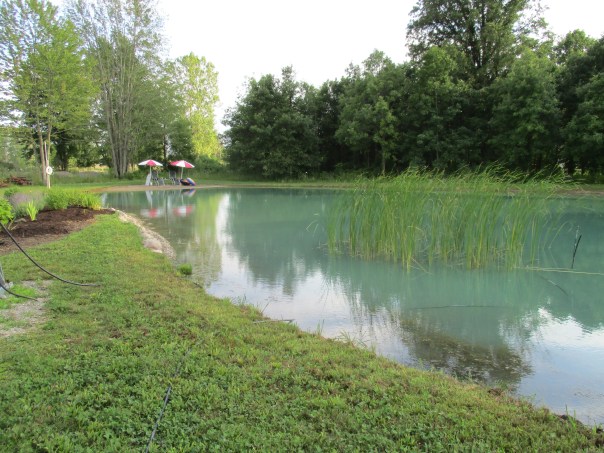With the temperatures warming and many dry days in the forecast it is time to get our irrigation system set up. Since I have many new readers I decided to republish this post written in 2016 to show you our irrigation system at the farm.
Don't Eat It! Soap and Skin Care
Since the farm does not have electricity hooked up, watering the gardens is not as easy as hooking up a hose and turning on a sprinkler. One of the reasons we put in the pond four years ago was to have the ability to use it for watering.

Our pond was dug according to the township requirements. I don’t remember the exact slope ratio but it has a gradual slope for the first 30 feet all the way around the edge. We gave it less of a slope at the beach area because we anticipate grandbabies playing in the water. After the first 30 feet it becomes a deep hole dropping down to 20+ feet. The clay bottom helps to retain water. So there is not much likelihood of it drying up.

In the spring of the following year we put up the windmill. Like the pond the windmill has…
View original post 712 more words
I am so impressed with out resourceful you and your husband are. Were we all so lucky to be able live more in tune with the land.
LikeLiked by 1 person
Thanks Angela. Some times it’s trial and error but when we find something that works I like to share it.
LikeLiked by 1 person
What a great idea, using the windmill to airfare the pond as well as help with irrigation.
Have you thought about mulching around your plants for water retention? It’s something that we learned from one of the YouTube channels that we watch. Once the plants are through the ground, place mulch around them. (We’re using straw.) I was skeptical at first, but the first day we did this convinced me of its benefits. We mulched around our tomato and squash plants after transplanting. The next day when we went to water, we used a soil tester we bought on Amazon to check the moisture reading. In all the areas we didn’t mulch (where we’re waiting for seeds to germinate) the soil was very dry. In the areas we mulched it was at the perfect moisture level. We love this method so much that we’re planning on mulching the rest of our open gardens, like the rhubarb and perennial gardens. I’ve also heard that this is a great way to keep the weed pressure down.
LikeLiked by 1 person
Yes we use straw sometimes for some plants but buying straw gets expensive too so we have to find a balance. In addition to keeping in moisture and keeping weeds down as straw deteriorates it helps to build the soil.
In the blueberry patch we use things like pine needles, oak sawdust, and leaves because they offer the acidity that the blueberries need.
In my prayer garden, where I grow mostly perennial herbs and flowers, we use wood mulch. It doesn’t break down a quickly as straw and looks better too. 🙂
Even with mulching we have had such dry spells in recent summers that watering is necessary.
LikeLiked by 1 person
No wonder you appreciated all that rain Ruth! We are getting torrential downpours on Saturday they say – hopefully you’re not that far from me and will get a good soaking as well. Also intermittent rain on Sunday and Monday. I’ll keep my fingers crossed that you get some. I hope we get it in the evenings because we have many people who have already begun setting off fireworks and will do so every night, but mostly on the holiday evenings, until way into August – worry about a stray one landing in the yard or on the roof.
LikeLike
Our forecast is for scattered thunderstorms for Saturday. We are not yet desperate for rain so some rain would be ok but not too much, but “beggars can’t be choosers” and “we can’t control the weather” so we prepare for the worst and pray for the best. The pump goes in the pond today so we are ready to water if needed. Have a great day Linda. Enjoy the sunshine!!! 🙂
LikeLiked by 1 person
Same here and they are saying a “real feel” of 95 to 100 degrees … where in the world was Spring? Enjoy the sunshine as well Ruth.
LikeLiked by 1 person
Wow! This is a lot of work I am sure, but absolutely Brilliant!! Thanks for sharing!
LikeLike
Thanks. It is not really hard work (easier than carrying buckets) but it does take a lot of time to keep everything watered during prolonged dry periods. During those times we at least pray for good winds. 🙂
LikeLiked by 1 person